A Fuzzy ANP-QFD Methodology for Determining Stakeholders in Product-Service Systems Development from Ecosystem Perspective
Abstract
1. Introduction
2. Related Work
2.1. Quality Function Deployment for Product-Service System (QFDforPSS)
2.2. Ecosystem Theory
3. A Proposed Fuzzy ANP-QFD Framework for PSS Ecosystem
3.1. PSS Ecosystem
3.1.1. The Stakeholders of PSS: An Ecosystem Perspective
- PSS Provider. PSS provider is the orchestrator of the product-service ecosystem, and it is often the focal company. The PSS provider is responsible for the final outcome and enables the value co-creation in an ecosystem. The relationship between PSS provider and the other actors can be classified into three categories, namely business-to-business (B2B), business-to-customers (B2C), and business-to-partners (B2P).
- Customers. The customer plays a role of both consumer and producer. On one hand, customers receive a PSS solution from the PSS provider, including product, service, or the integration of product and service. On the other hand, they co-operate with stakeholders in the ecosystem. A number of customers form a customer network. The relationship among elements in the customer network is customer-to-customer (C2C). They can communicate on social media or social networks.
- Suppliers. Suppliers are responsible for providing hardware, software, and service. Correspondingly, they include module supplier, component supplier, software vendors, and service supplier. The module supplier is responsible for providing a PSS module throughout the lifecycle. The component supplier provides a physical component directly to customers or PSS provider. The service provider is responsible for delivering service directly to customers. They form different kinds of supplier networks according to their role, including module supplier network, component supplier network, software vendor network, and service supplier network. The relationship among elements in the supplier network is supplier-to-supplier (S2S).
- Partners. Partners are stakeholders providing complementary capabilities and resources. They play an important role as a complementor in the ecosystem, they are typically technology partners, system integrators, and channel partners. They form partner networks, including technology partner network, system integrators network, and channel partner network. The relationship among elements in the partner network is partner-to-partner (P2P).
3.1.2. The Relationship among Stakeholders and BOM
3.2. A Fuzzy ANP-QFD Model for PSS to Determine Stakeholders
3.3. The Process of the Proposed Model
3.3.1. Stage 1: Identification of the Relationship between Customer Requirements and Quality Characteristics in QBOM
3.3.2. Stage 2: Identification of the Relationship between QBOM and BOM
3.3.3. Stage 3: Identification of the Relationship between BOM and Stakeholders
4. Case Study
4.1. PSS Ecosystem in the Automobile Aftermarket
4.2. The Application of Proposed Model for Product-Service Ecosystem in Automobile Aftermarket
4.2.1. Identification of the Relationship between Customer Requirements and QBOM in Automobile Aftermarket
4.2.2. Identification of the Relationship between QBOM and BOM in Automobile Aftermarket
4.2.3. Identification of the Relationship between BOM and Stakeholders for QME in Automobile Aftermarket
5. Discussion
5.1. Theoretical Implication
5.2. Practical Implication
6. Conclusions and Future Directions
Author Contributions
Funding
Acknowledgments
Conflicts of Interest
References
- West, S.; Gaiardelli, P.; Resta, B.; Kujawski, D. Co-creation of value in product-service systems through transforming data into knowledge. IFAC-PapersOnLine 2018, 51, 1323–1328. [Google Scholar] [CrossRef]
- Zheng, M.; Ming, X.; Wang, L.; Yin, D.; Zhang, X. Status review and future perspectives on the framework of smart product service ecosystem. Procedia CIRP 2017, 64, 181–186. [Google Scholar] [CrossRef]
- Cibat, J.; Süße, T.; Wilkens, U. An ecosystem approach as a design principle for a PSS-specific business simulation. Procedia CIRP 2017, 64, 223–228. [Google Scholar] [CrossRef]
- Geng, X.; Chu, X.; Xue, D.; Zhang, Z. A systematic decision-making approach for the optimal product-service system planning. Expert Syst. Appl. 2011, 38, 11849–11858. [Google Scholar] [CrossRef]
- Bustinza, O.F.; Gomes, E.; Vendrell-Herrero, F.; Baines, T. Product-service innovation and performance: The role of collaborative partnerships and R&D intensity. R&D Manag. 2017, 49, 33–45. [Google Scholar] [CrossRef]
- Fargnoli, M.; Haber, N. A practical ANP-QFD methodology for dealing with requirements’ inner dependency in PSS development. Comput. Ind. Eng. 2019, 127, 536–548. [Google Scholar] [CrossRef]
- Haber, N.; Fargnoli, M.; Sakao, T. Integrating QFD for product-service systems with the Kano model and fuzzy AHP. Total Qual. Manag. Bus. Excel. 2018. [Google Scholar] [CrossRef]
- Geng, X.; Chu, X.; Xue, D.; Zhang, Z. An integrated approach for rating engineering characteristics’ final importance in product-service system development. Comput. Ind. Eng. 2010, 59, 585–594. [Google Scholar] [CrossRef]
- Neely, A.; Neely, A.D. Exploring the financial consequences of the servitization of manufacturing. Oper. Manag. Res. 2008, 1, 103–118. [Google Scholar] [CrossRef]
- Hockerts, K.; Weaver, N. Towards a theory of sustainable product service systems—What are the dependent and independent variables of S-PSS? In Proceedings of the INSEAD-CMER Research Workshop on Sustainable Product Service Systems—Key Definitions and Concepts, Fontainebleau, France, 9 May 2002. [Google Scholar]
- Song, W.; Sakao, T. Service conflict identification and resolution for design of product-service offerings. Comput. Ind. Eng. 2016, 98, 91–101. [Google Scholar] [CrossRef]
- Fargnoli, M.; Sakao, T. Uncovering differences and similarities among quality function deployment based methods in design for X: Benchmarking in different domains. Qual. Eng. 2016, 29, 690–712. [Google Scholar] [CrossRef]
- Jacobides, M.G.; Cennamo, C.; Gawer, A. Towards a theory of ecosystems. Strateg. Manag. J. 2018, 39, 2255–2276. [Google Scholar] [CrossRef]
- Durugbo, C. Collaborative networks: A systematic review and multi-level framework. Int. J. Prod. Res. 2015, 54, 3749–3776. [Google Scholar] [CrossRef]
- Teece, D.J. Explicating dynamic capabilities: The nature and microfoundations of (sustainable) enterprise performance. Strateg. Manag. J. 2007, 28, 1319–1350. [Google Scholar] [CrossRef]
- Alaimo, C.; Kallinikos, J.; Valderrama, E. Platforms as service ecosystems: Lessons from social media. J. Inf. Technol. 2019, 35, 25–48. [Google Scholar] [CrossRef]
- Acs, Z.J.; Stam, E.; Audretsch, D.B.; O’Connor, A. The lineages of the entrepreneurial ecosystem approach. Small Bus. Econ. 2017, 49, 1–10. [Google Scholar] [CrossRef]
- Spigel, B.; Harrison, R.J. Toward a process theory of entrepreneurial ecosystems. Strateg. Entrep. J. 2017, 12, 151–168. [Google Scholar] [CrossRef]
- Granstrand, O.; Holgersson, M. Innovation ecosystems: A conceptual review and a new definition. Technovation 2020. [Google Scholar] [CrossRef]
- Chen, Z.; Dahlgaard-Park, S.M.; Yu, L. Service quality management and ecosystem theory. Total Qual. Manag. Bus. Excel. 2014, 25, 1190–1205. [Google Scholar] [CrossRef]
- Fayoumi, A. Ecosystem-inspired enterprise modelling framework for collaborative and networked manufacturing systems. Comput. Ind. 2016, 80, 54–68. [Google Scholar] [CrossRef]
- Aarikka-Stenroos, L.; Ritala, P. Network management in the era of ecosystems: Systematic review and management framework. Ind. Mark. Manag. 2017, 67, 23–36. [Google Scholar] [CrossRef]
- Adner, R. Ecosystem as structure: An actionable construct for strategy. J. Manag. 2017, 43, 39–58. [Google Scholar] [CrossRef]
- Kuhlenkötter, B.; Wilkens, U.; Bender, B.; Abramovici, M.; Suesse, T.; Göbel, J.; Herzog, M.; Hypki, A.; Lenkenhoff, K. New perspectives for generating smart PSS solutions—Life cycle, methodologies and transformation. Procedia CIRP 2017, 64, 217–222. [Google Scholar] [CrossRef]
- Meier, H.; Roy, R.; Seliger, G. Industrial product-service systems—IPS 2. CIRP Ann. 2010, 59, 607–627. [Google Scholar] [CrossRef]
- Phillips, M.A.; Ritala, P. A complex adaptive systems agenda for ecosystem research methodology. Technol. Forecast. Soc. Chang. 2019, 148, 119739. [Google Scholar] [CrossRef]
- Parasuraman, A.; Zeithaml, V.A.; Berry, L.L. SERVQUAL: A multiple-item scale for measuring consumer perception of service quality. J. Retail. 1988, 64, 2–40. [Google Scholar]
- Ocampo, L.; Alinsub, J.; Casul, R.A.; Enquig, G.; Luar, M.; Panuncillon, N.; Bongo, M.; Ocampo, C.O. Public service quality evaluation with SERVQUAL and AHP-TOPSIS: A case of Philippine government agencies. Socio-Econ. Plan. Sci. 2019, 68, 100604. [Google Scholar] [CrossRef]
- Chang, D.-Y. Applications of the extent analysis method on fuzzy AHP. Eur. J. Oper. Res. 1996, 95, 649–655. [Google Scholar] [CrossRef]
- Mavi, R.K.; Standing, C. Critical success factors of sustainable project management in construction: A fuzzy DEMATEL-ANP approach. J. Clean. Prod. 2018, 194, 751–765. [Google Scholar] [CrossRef]

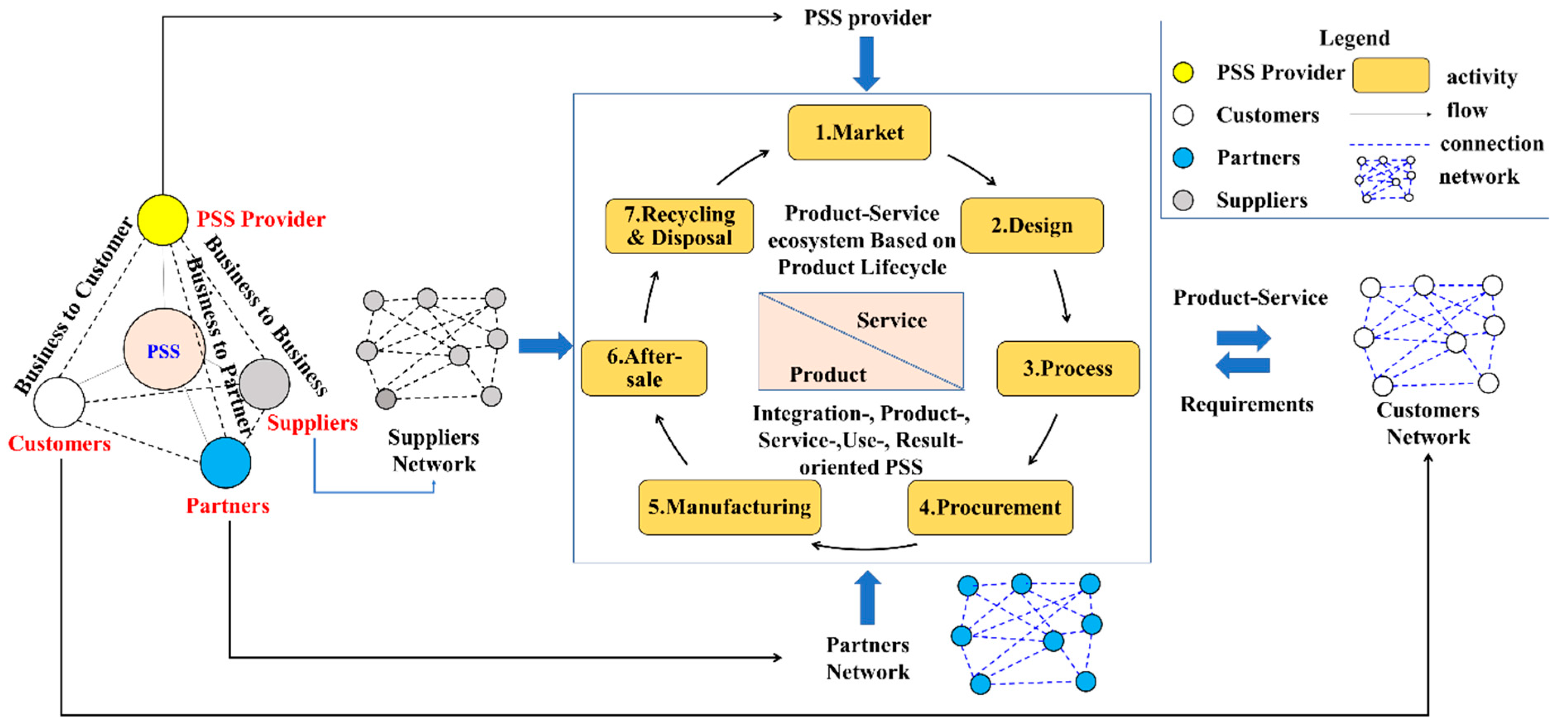
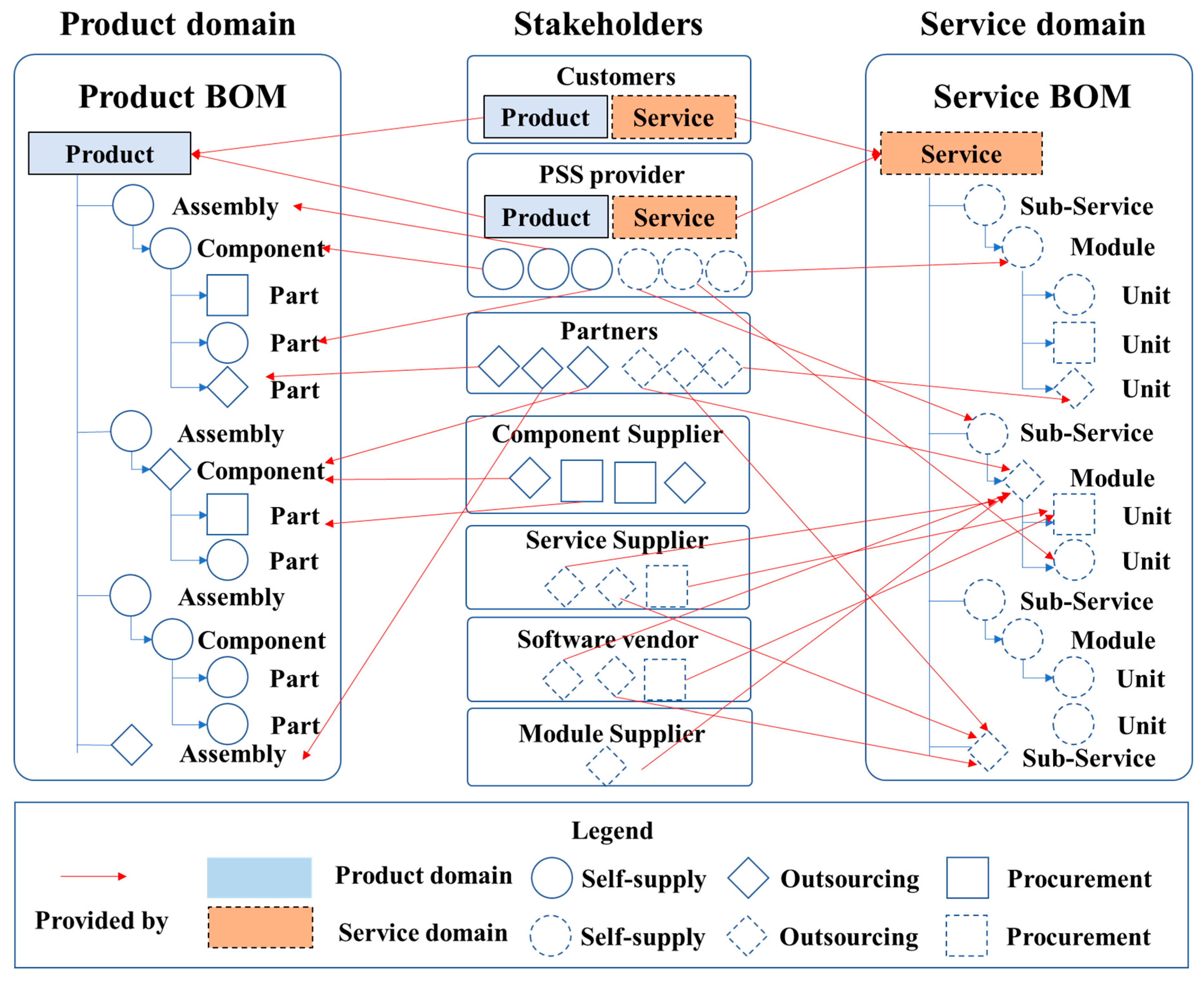
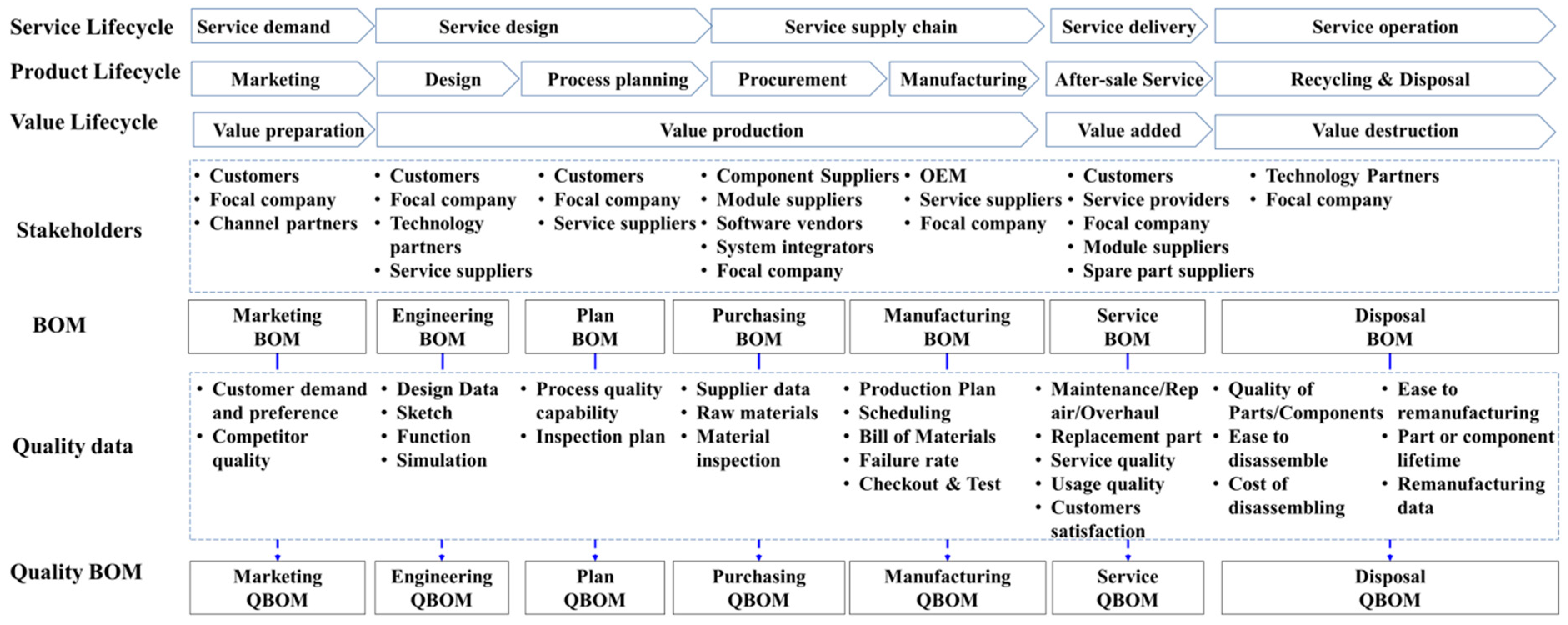
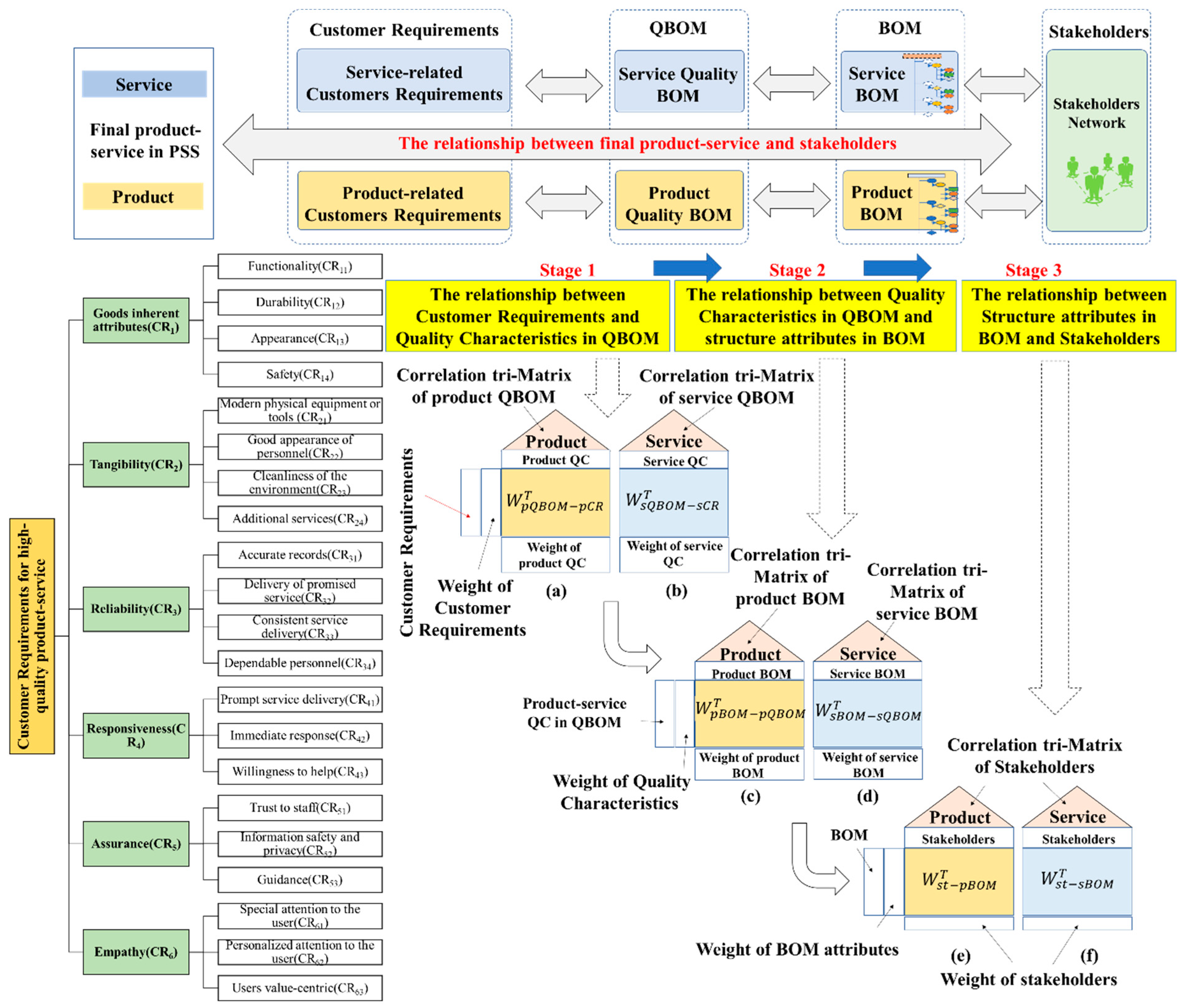
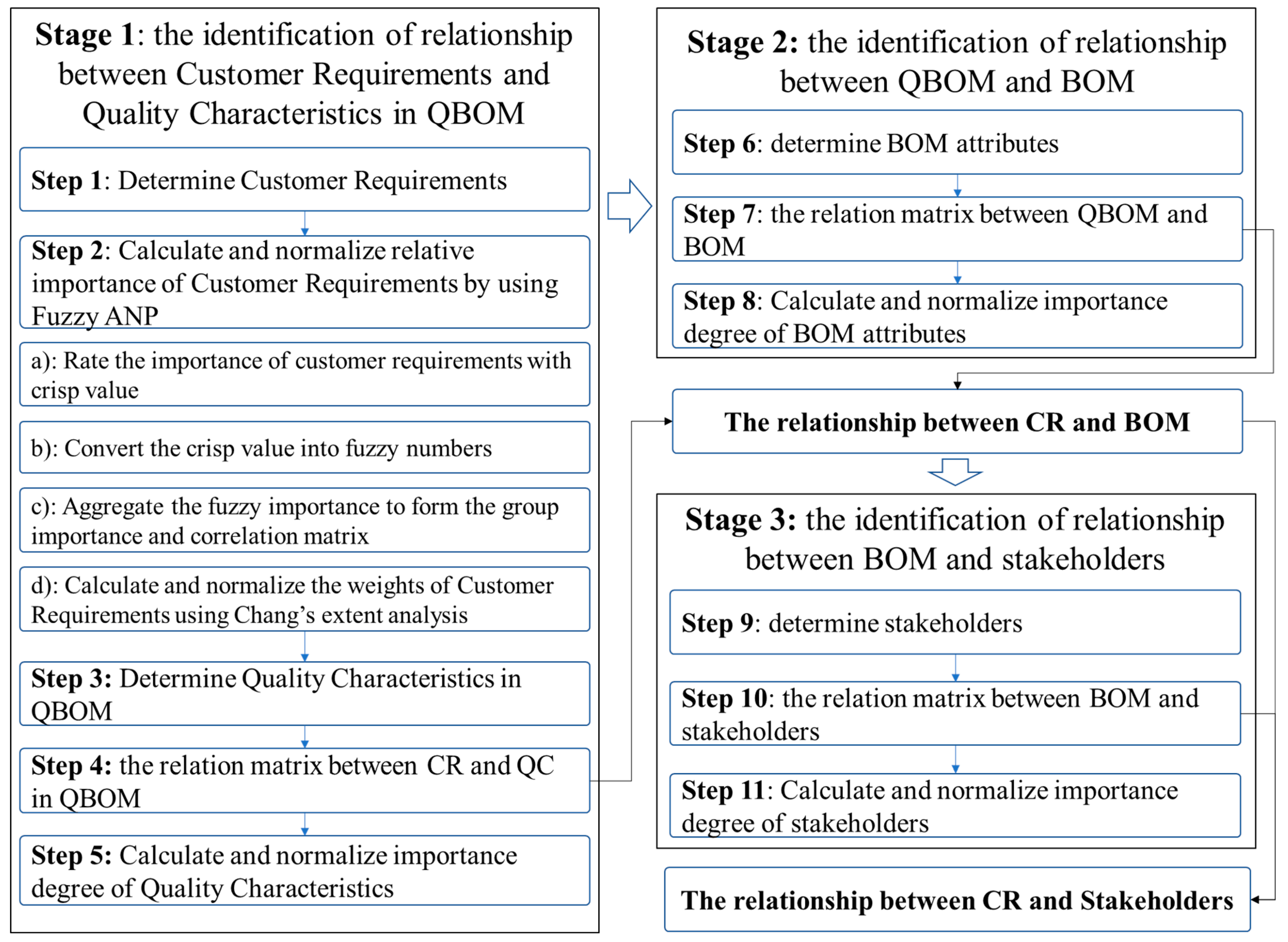

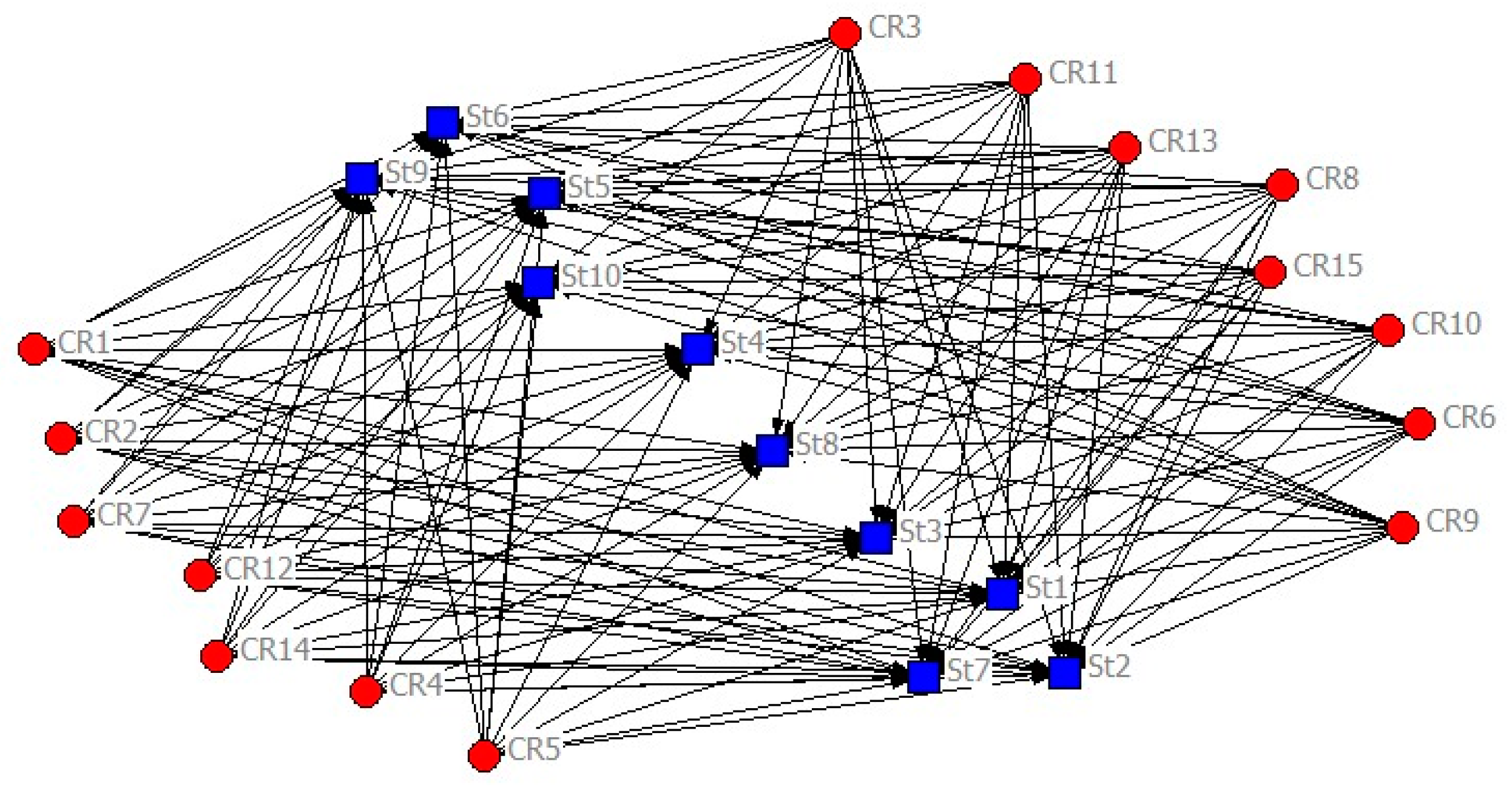
| Literatures | Research Theme | PSS Modeling | Linkage between PSS Offerings and Stakeholders | Methods |
|---|---|---|---|---|
| Geng et al. [8] | Relationship between customer requirements and engineering characteristics in PSS development | ANP network model of house of quality (HoQ) | N/A | Fuzzy ANP-QFD |
| Geng et al. [4] | Decision-making approach for PSS planning | ANP network model of house of quality (HoQ) | N/A | Data envelopment analysis, fuzzy kano model |
| Fargnoli and Sakao [12] | QFD-based methods in Design for X | QFD for PSS | N/A | QFD-based DfX methods |
| Haber, Fargnoli, and Sakao [7] | Customer requirements analysis for PSS development | fuzzy ANP-QFD for PSS | N/A | Fuzzy ANP-QFD, kano model |
| Fargnoli and Haber [6] | ANP-QFD methodology for PSS development | ANP-QFD for PSS | N/A | ANP-QFD |
| Chen, Dahlgaard-Park, and Yu [20] | A framework model for service ecosystem based on value co-creation to manage service quality | Service ecosystem | N/A | Ecosystem theory |
| Zheng et al. [2] | Framework of Smart Product Service Ecosystem | Service ecosystem | N/A | Conceptual framework |
| Kuhlenkötter et al. [24] | Conceptualizing Smart PSS value creation as digital ecosystem | Digital-based ecosystem | N/A | Smart engineering |
| Cibat, Süße, and Wilkens [3] | PSS business simulation | Ecosystem | N/A | Business simulation |
| West et al. [1] | Value co-creation in PSS | Ecosystem | N/A | Survey |
| Dimension | Sub-Dimension | Description |
|---|---|---|
| Goods inherent attributes (CR1) | Functionality (CR11) | The function and performance of components in PSS meet customers’ needs. |
| Durability (CR12) | The lifetime under normal circumstances is long. | |
| Appearance (CR13) | The shape, color, and layout is beautiful and attractive. | |
| Safety (CR14) | The automobile has the capability to protect drivers. | |
| Tangibility (CR2) | Modern physical equipment or tools (CR21) | The focal company has modern equipment or tools. |
| Good appearance of personnel (CR22) | The appearance of the staff is elegant. | |
| Cleanliness of the environment (CR23) | The environment is clean and comfortable. | |
| Additional services (CR24) | Additional services (such as life service) are convenient. | |
| Reliability (CR3) | Accurate records (CR31) | The maintenance records are up-to-date. |
| Delivery of promised service (CR32) | The staff provide service as promised. | |
| Consistent service delivery (CR33) | Same service is provided to different customers in similar cases. | |
| Dependable personnel (CR34) | Qualified personnel is arranged to deliver service. | |
| Responsiveness (CR4) | Prompt service delivery (CR41) | Service are provided without delay. |
| Immediate reponse (CR42) | Speed handling request and respond immediately. | |
| Willingness to help (CR43) | Staffs are willing to help customers whenever needed. | |
| Assurance (CR5) | Trust to staff (CR51) | Staff’s performance inspires trust. |
| Information safety and privacy (CR52) | Security and privacy of personal infromation is assured. | |
| Guidance (CR53) | Knowledge or ability to deal with users’ problems. | |
| Empathy (CR6) | Special attention to the user (CR61) | Staff pay special attention to customers’ needs. |
| Personalized attention to the user (CR62) | Staff are concerned about customers’ individual requests. | |
| Users value-centric (CR63) | Customers’ compliants and suggestions taken into account. |
| Linguistic Variables | Scores | Triangle Fuzzy Number |
|---|---|---|
| Absolutely more important | 9 | (3,4,5) |
| Very strongly more important | 7 | (2,3,4) |
| More important | 5 | (1,2,3) |
| Weekly more important | 3 | (1,1,2) |
| Equally important | 1 | (0,0.5,1) |
| Linguistic Variables | Triangle Fuzzy Number |
|---|---|
| Very high infulence | (0.8, 0.9, 1) |
| High influence | (0.6, 0.7, 0.8) |
| Medium influence | (0.4, 0.5, 0.6) |
| Low influence | (0.05, 0.3, 0.4) |
| Very low influence | (0, 0, 0.05) |
| Stakeholders | Role | Responsibility |
|---|---|---|
| Company CX | Platform Provider and Regulator | Orchestrating the product-service ecosystem in the automobile market. |
| Customers | Consumer and Producer | Providing requirements and evaluating the final product-service. |
| Spare part suppliers | Product Supplier | Providing satisfactory spare part and component to the platform and assuring quality. |
| Automobile company | Product Supplier | Providing satisfactory new vehicle to Company CX and assuring quality. |
| Vehicle Service provider | Service Supplier | Providing satisfactory MRO and refitting to the platform and assuring quality. |
| Life Service provider | Service Partner | Providing car sharing, rental, insurance to the customers, and assuring quality. |
| Society | Product Partner | Providing a second-hand car to the customers and assuring quality. |
| E-commerce | Channel Partner | Information acquisition and working as marketing channel. |
| CR1 | CR2 | … | CR14 | CR15 | |
|---|---|---|---|---|---|
| CR1 | (0, 0.5,1) | (1.122,1.698,2.749) | … | (1,1.26,2.289) | (1,1.26,2.289) |
| CR2 | (0.364,0.589,0.891) | (0, 0.5,1) | (1,1,2) | (1.122,1.201,2.245) | |
| CR3 | (0.408, 0.707,1) | (0.371,0.618,0.749) | (1.122,1.201,2.245) | (1.122,1.513,2.57) | |
| CR4 | (0.467,0.891,1) | (0.347,0.55,0.794) | (1.906,2.942,1.122) | (1.122,1.348,2.402) | |
| CR5 | (0.389,0.661,0.891) | (0.389,0.661,0.891) | (1, 1,2) | (1,1,2) | |
| CR6 | (0.437,0.794,1) | (0.35,0.561,0.833) | (1, 2,3) | (1,1.26,2.289) | |
| … | … | ||||
| CR14 | (0.437,0.794,1) | (0.5, 1,1) | (0, 0.5,1) | (1,1.122,2.14) | |
| CR15 | (0.437,0.794,1) | (0.445,0.833,0.891) | … | (0.467,0.891,1) | (0, 0.5,1) |
| S1 | S2 | S3 | S4 | S5 | S6 | S7 | S8 | S9 | S10 | S11 | S12 | S13 | S14 | S15 | |
|---|---|---|---|---|---|---|---|---|---|---|---|---|---|---|---|
| * | 0.987 | 0.979 | 1 | 1 | 1 | 1 | 1 | 1 | 1 | 1 | 1 | 1 | 1 | 1 | |
| 1 | * | 0.992 | 1 | 1 | 1 | 1 | 1 | 1 | 1 | 1 | 1 | 1 | 1 | 1 | |
| 1 | 1 | * | 1 | 1 | 1 | 1 | 1 | 1 | 1 | 1 | 1 | 1 | 1 | 1 | |
| 0.979 | 0.965 | 0.957 | * | 1 | 1 | 1 | 1 | 1 | 1 | 1 | 1 | 1 | 1 | 1 | |
| 0.952 | 0.937 | 0.929 | 0.974 | * | 1 | 1 | 1 | 1 | 1 | 1 | 1 | 1 | 1 | 1 | |
| 0.948 | 0.933 | 0.925 | 0.97 | 0.998 | * | 1 | 1 | 1 | 1 | 1 | 1 | 1 | 1 | 1 | |
| 0.877 | 0.862 | 0.855 | 0.9 | 0.927 | 0.931 | * | 0.989 | 1 | 1 | 1 | 1 | 1 | 1 | 1 | |
| 0.883 | 0.867 | 0.86 | 0.906 | 0.935 | 0.94 | 1 | * | 1 | 1 | 1 | 1 | 1 | 1 | 1 | |
| 0.828 | 0.812 | 0.805 | 0.852 | 0.883 | 0.889 | 0.964 | 0.952 | * | 1 | 1 | 1 | 1 | 1 | 1 | |
| 0.819 | 0.803 | 0.795 | 0.845 | 0.877 | 0.883 | 0.963 | 0.951 | 1 | * | 1 | 1 | 1 | 1 | 1 | |
| 0.717 | 0.703 | 0.697 | 0.741 | 0.77 | 0.779 | 0.852 | 0.841 | 0.887 | 0.888 | * | 0.962 | 1 | 0.991 | 0.977 | |
| 0.716 | 0.7 | 0.694 | 0.741 | 0.777 | 0.787 | 1 | 0.859 | 1 | 1 | 1 | * | 1 | 1 | 1 | |
| 0.641 | 0.626 | 0.622 | 0.667 | 0.7 | 0.712 | 0.793 | 0.782 | 0.833 | 0.836 | 0.962 | 0.919 | * | 0.953 | 0.937 | |
| 0.644 | 0.644 | 0.622 | 0.673 | 0.71 | 0.724 | 0.816 | 0.803 | 0.862 | 0.864 | 1 | 0.962 | 1 | * | 0.981 | |
| 0.62 | 0.601 | 0.597 | 0.652 | 0.693 | 0.709 | 0.812 | 0.797 | 0.865 | 0.867 | 1 | 0.978 | 1 | 1 | * |
| QC1 | QC2 | … | QC 7 | |
|---|---|---|---|---|
| CR1 | (0.755,0.856,0.956) | (0.8,0.9,1) | … | (0.05,0.3,0.4) |
| CR2 | (0.6,0.7,0.8) | (0.4, 0.5,0.6) | (0.05,0.3,0.4) | |
| CR3 | (0.05,0.3,0.4) | (0.05,0.3,0.4) | (0.755,0.856,0.956) | |
| CR4 | (0.05,0.3,0.4) | (0.755,0.856,0.956) | (0.05,0.3,0.4) | |
| CR5 | (0.05,0.3,0.4) | (0.05,0.3,0.4) | (0.4, 0.5,0.6) | |
| CR6 | (0.05,0.3,0.4) | (0.05,0.3,0.4) | (0.8,0.9,1) | |
| … | … | |||
| CR14 | (0.05,0.3,0.4) | (0.6,0.7,0.8) | (0.8,0.9,1) | |
| CR15 | (0.553,0.654,0.755) | (0.553,0.654,0.755) | … | (0.4, 0.5,0.6) |
| BA1 | BA2 | … | BA5 | BA6 | |
|---|---|---|---|---|---|
| QC1 | (0.8,0.9,1) | (0.05, 0.3,0.4) | … | (0.05, 0.3,0.4) | (0.05, 0.3,0.4) |
| QC2 | (0.6,0.7,0.8) | (0.755,0.856,0.956) | (0.434,0.535,0.636) | (0.05, 0.3,0.4) | |
| QC3 | (0.05, 0.3,0.4) | (0.05, 0.3,0.4) | (0.8,0.9,1) | (0.434,0.687,0.796) | |
| QC4 | (0.51,0.612,0.713) | (0.755,0.856,0.956) | (0.755,0.856,0.956) | (0.8,0.9,1) | |
| QC5 | (0.553,0.654,0.755) | (0.05, 0.3,0.4) | (0.8,0.9,1) | (0.434,0.535,0.636) | |
| QC6 | (0.51,0.612,0.713) | (0.05, 0.3,0.4) | (0.755,0.856,0.956) | (0.8,0.9,1) | |
| QC7 | (0.553,0.654,0.755) | (0.05, 0.3,0.4) | … | (0.8,0.9,1) | (0.05, 0.3,0.4) |
| St1 | St2 | … | St9 | St10 | |
|---|---|---|---|---|---|
| BA1 | (0.05, 0.3,0.4) | (0.648,0.75,0.853) | … | (0.05,0.3,0.4) | (0.05,0.3,0.4) |
| BA2 | (0.05, 0.3,0.4) | (0.763, 0.863,963) | (0.05,0.3,0.4) | (0.05,0.3,0.4) | |
| BA3 | (0.05, 0.3,0.4) | (0.05,0.3,0.4) | (0.05,0.3,0.4) | (0.05,0.3,0.4) | |
| BA4 | (0.071,0.327,0.428) | (0.648,0.75,0.853) | (0.05,0.3,0.4) | (0.34,0.536,0.641) | |
| BA5 | (0.727,0.828,0.928) | (0.05,0.3,0.4) | (0.05,0.3,0.4) | (0.224,0.465,0.571) | |
| BA6 | (0.648,0.75,0.853) | (0.05,0.3,0.4) | … | (0.727,0.828,0.928) | (0.071, 0.327,0.428) |
| St1 | Crisp | St2 | Crisp | St3 | Crisp | St4 | Crisp | St5 | Crisp | |
|---|---|---|---|---|---|---|---|---|---|---|
| CR1 | (1.384, 5.966, 10.138) | 5.864 | (1.795, 6.503, 10.936) | 6.434 | (2.403, 7.297, 12.037) | 7.259 | (2.491, 7.392, 12.143) | 7.355 | (2.440, 7.169, 11.802) | 7.145 |
| CR2 | (1.147, 4.861, 8.531) | 4.850 | (1.447, 5.259, 9.156) | 5.280 | (1.815, 5.837, 10.010) | 5.875 | (2.051, 6.027, 10.219) | 6.081 | (1.763, 5.690, 9.769) | 5.728 |
| CR3 | (2.665, 6.846, 11.186) | 6.886 | (2.052, 6.914, 11.526) | 6.851 | (2.202, 7.569, 12.497) | 7.459 | (3.259, 8.124, 13.061) | 8.142 | (2.119, 7.311, 12.127) | 7.217 |
| CR4 | (2.077, 6.335, 10.525) | 6.318 | (2.053, 6.683, 11.135) | 6.639 | (2.296, 7.307, 12.065) | 7.244 | (2.865, 7.649, 12.419) | 7.645 | (2.254, 7.102, 11.753) | 7.053 |
| CR5 | (1.214, 4.457, 7.877) | 4.501 | (0.936, 4.583, 8.212) | 4.578 | (1.061, 5.046, 8.936) | 5.022 | (1.575, 5.345, 9.257) | 5.381 | (0.998, 4.896, 8.697) | 4.872 |
| CR6 | (1.426, 5.313, 9.099) | 5.288 | (1.300, 5.532, 9.553) | 5.479 | (1.485,6.109, 10.412) | 6.029 | (2.176, 6.525, 10.846) | 6.518 | (1.338, 5.866, 10.072) | 5.786 |
| CR7 | (1.785, 5.593, 9.468) | 5.610 | (1.457, 5.757, 9.872) | 5.710 | (1.658, 6.355, 10.758) | 6.281 | (2.453, 6.790, 11.210) | 6.811 | (1.503, 6.096, 10.400) | 6.024 |
| CR8 | (1.753, 6.042, 10.188) | 6.006 | (1.761, 6.377, 10.787) | 6.325 | (1.899, 6.947, 11.665) | 6.865 | (2.481, 7.297, 12.026) | 7.275 | (2.083, 6.877, 11.486) | 6.831 |
| CR9 | (2.853, 7.414, 12.096) | 7.445 | (2.873, 7.868, 12.844) | 7.863 | (3.436, 8.735, 14.049) | 8.739 | (4.189, 9.076, 14.393) | 9.183 | (3.350, 8.466, 13.659) | 8.485 |
| CR10 | (3.692, 8.619, 13.680) | 8.652 | (3.206, 8.861, 14.242) | 8.793 | (3.548, 9.633, 15.373) | 9.547 | (4.624, 10.171, 15.909) | 10.219 | (3.567, 9.417, 15.027) | 9.357 |
| CR11 | (2.331, 6.895, 11.326) | 6.862 | (2.228, 7.194, 11.900) | 7.129 | (2.737, 8.011, 13.037) | 7.949 | (3.263, 8.296, 13.330) | 8.296 | (2.614, 7.767, 12.680) | 7.707 |
| CR12 | (1.708, 5.778, 9.750) | 5.753 | (1.884, 6.168, 10.386) | 6.151 | (1.874, 6.640, 11.151) | 6.576 | (2.328, 6.954, 11.480) | 6.929 | (1.905, 6.505, 10.915) | 6.458 |
| CR13 | (2.813, 7.485, 12.140) | 7.481 | (2.613, 7.765, 12.711) | 7.713 | (3.278, 8.697, 13.977) | 8.662 | (4.041, 9.072, 14.356) | 9.135 | (3.112, 8.384, 13.545) | 8.356 |
| CR14 | (3.199, 7.856, 12.646) | 7.889 | (2.788, 8.082, 13.172) | 8.031 | (3.465, 9.041,14.474) | 9.006 | (4.373, 9.457, 14.892) | 9.545 | (3.310,8.722, 14.032) | 8.697 |
| CR15 | (2.857, 7.260, 11.870) | 7.312 | (2.744, 7.625, 12.525) | 7.630 | (3.154, 8.382, 13.614) | 8.383 | (3.958, 8.771, 14.010) | 8.877 | (3.134, 8.162, 13.276) | 8.183 |
| St6 | Crisp | St7 | Crisp | St8 | Crisp | St9 | Crisp | St10 | Crisp | |
| CR1 | (1.038, 5.106, 8.970) | 5.055 | (0.876, 4.642, 8.293) | 4.613 | (0.617, 0.720, 0.821) | 0.719 | (0.617, 4.701, 8.392) | 4.603 | (0.613, 4.528, 8.163) | 4.458 |
| CR2 | (0.939, 4.179, 7.563) | 4.215 | (0.774, 3.780, 6.972) | 3.826 | (0.472, 3.635, 6.780) | 3.631 | (0.525, 3.808, 7.034) | 3.794 | (0.538, 3.683, 6.857) | 3.690 |
| CR3 | (1.728, 5.733, 9.762) | 5.739 | (1.443, 5.167, 8.977) | 5.189 | (1.108, 4.982, 8.739) | 4.953 | (1.258, 5.240, 9.087) | 5.206 | (0.972, 5.028, 8.825) | 4.963 |
| CR4 | (1.436, 5.379, 9.265) | 5.365 | (1.195, 4.858, 8.532) | 4.860 | (0.908, 4.698, 8.320) | 4.656 | (1.026, 4.934, 8.644) | 4.884 | (0.823, 4.732, 8.391) | 4.669 |
| CR5 | (0.830, 3.751, 6.896) | 3.807 | (0.690, 3.388, 6.351) | 3.454 | (0.481, 3.267, 6.186) | 3.300 | (0.545, 3.432, 6.427) | 3.459 | (0.462, 3.298, 6.245) | 3.326 |
| CR6 | (1.183, 4.583, 8.079) | 4.607 | (0.968, 4.115, 7.414) | 4.153 | (0.461, 3.841, 7.091) | 3.809 | (0.513, 4.020, 7.353) | 3.976 | (0.640, 3.993, 7.277) | 3.976 |
| CR7 | (1.334, 4.785, 8.367) | 4.818 | (1.097, 4.298, 7.680) | 4.343 | (0.678, 4.064, 7.397) | 4.051 | (0.765, 4.263, 7.679) | 4.242 | (0.733, 4.174, 7.542) | 4.156 |
| CR8 | (0.997, 5.025, 8.865) | 4.978 | (0.868, 4.574, 8.202) | 4.555 | (0.716, 4.480, 8.056) | 4.433 | (0.804, 4.703, 8.367) | 4.644 | (0.594, 4.464, 8.076) | 4.400 |
| CR9 | (2.051, 6.355, 10.710) | 6.368 | (1.706, 5.736, 9.859) | 5.760 | (1.190, 5.502, 9.570) | 5.441 | (1.337, 5.769, 9.933) | 5.702 | (1.171, 5.585, 9.694) | 5.509 |
| CR10 | (2.343, 7.176, 11.896) | 7.148 | (1.977, 6.499, 10.973) | 6.487 | (1.551, 6.328, 10.743) | 6.238 | (1.755, 6.653, 11.169) | 6.557 | (1.346, 6.334, 10.796) | 6.202 |
| CR11 | (1.648, 5.835, 9.949) | 5.817 | (1.363, 5.276, 9.168) | 5.271 | (1.058, 5.144, 8.985) | 5.083 | (1.196, 5.407, 9.340) | 5.337 | (0.946, 5.143, 9.021) | 5.063 |
| CR12 | (1.128, 4.872, 8.547) | 4.855 | (0.940, 4.411, 7.883) | 4.411 | (0.817, 4.319, 7.741) | 4.299 | (0.926, 4.540, 8.048) | 4.513 | (0.659, 4.302, 7.759) | 4.255 |
| CR13 | (2.120, 6.410, 10.741) | 6.420 | (1.759, 5.777, 9.877) | 5.798 | (1.049, 5.466, 9.512) | 5.373 | (1.172, 5.724, 9.866) | 5.622 | (1.187, 5.615, 9.703) | 5.530 |
| CR14 | (2.284, 6.685, 11.145) | 6.700 | (1.902, 6.028, 10.252) | 6.053 | (1.247, 5.740, 9.908) | 5.659 | (1.401, 6.017, 10.284) | 5.930 | (1.286, 5.862, 10.074) | 5.771 |
| CR15 | (1.918, 6.139, 10.424) | 6.155 | (1.606, 5.552, 9.607) | 5.579 | (1.228, 5.386, 9.385) | 5.346 | (1.385, 5.656, 9.751) | 5.612 | (1.104, 5.410, 9.451) | 5.344 |
| Research Study | This Study | Fargnoli and Haber [6] | Fargnoli and Sakao [12] | Haber, Fargnoli, and Sakao [7] |
|---|---|---|---|---|
| Input of phase 1 | Customer requirements | Reciver state parameters | Customer values | Customer requirements |
| Output of phase 1 | Quality characteristics | Product characteristics, service characteristic | Important characteristics of product and service | Importance of Reciver state parameters |
| Output of phase 2 | BOM attributes | Product components, service components | Important components of product and service | Importance of product and service characteristics |
| Output of phase 3 | Stakeholders | N/A | N/A | Importance of product and service components |
© 2020 by the authors. Licensee MDPI, Basel, Switzerland. This article is an open access article distributed under the terms and conditions of the Creative Commons Attribution (CC BY) license (http://creativecommons.org/licenses/by/4.0/).
Share and Cite
Yin, D.; Ming, X.; Liu, Z.; Zhang, X. A Fuzzy ANP-QFD Methodology for Determining Stakeholders in Product-Service Systems Development from Ecosystem Perspective. Sustainability 2020, 12, 3329. https://doi.org/10.3390/su12083329
Yin D, Ming X, Liu Z, Zhang X. A Fuzzy ANP-QFD Methodology for Determining Stakeholders in Product-Service Systems Development from Ecosystem Perspective. Sustainability. 2020; 12(8):3329. https://doi.org/10.3390/su12083329
Chicago/Turabian StyleYin, Dao, Xinguo Ming, Zhiwen Liu, and Xianyu Zhang. 2020. "A Fuzzy ANP-QFD Methodology for Determining Stakeholders in Product-Service Systems Development from Ecosystem Perspective" Sustainability 12, no. 8: 3329. https://doi.org/10.3390/su12083329
APA StyleYin, D., Ming, X., Liu, Z., & Zhang, X. (2020). A Fuzzy ANP-QFD Methodology for Determining Stakeholders in Product-Service Systems Development from Ecosystem Perspective. Sustainability, 12(8), 3329. https://doi.org/10.3390/su12083329







